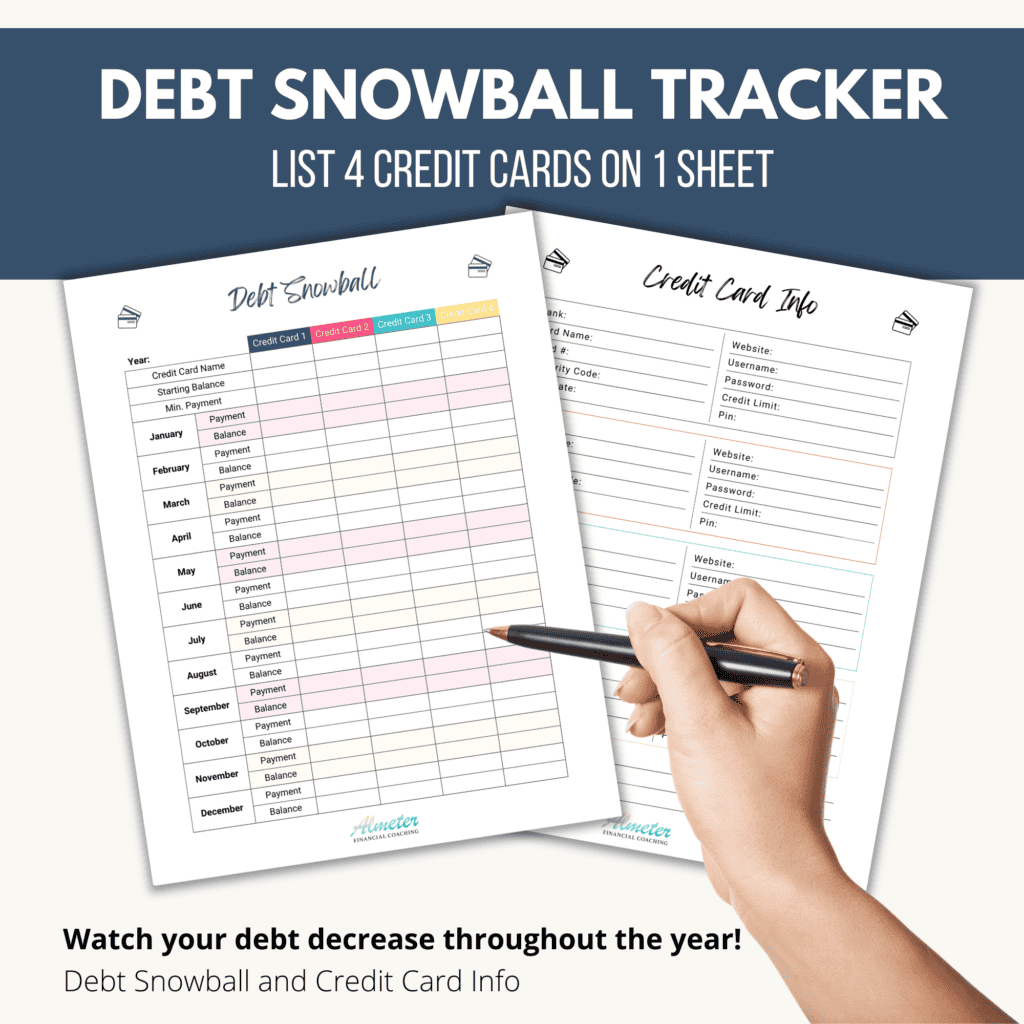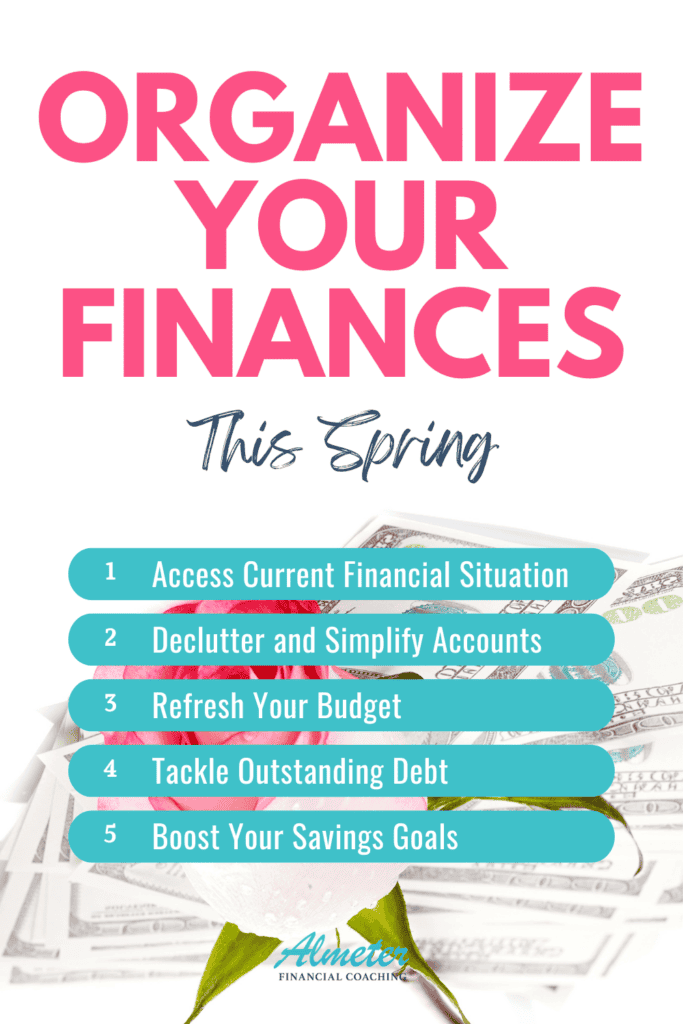This post may contain affiliate links. As an Amazon Associate I may earn from qualifying purchases at no additional costs to you. Please see the Policies pages for more info.
Financial Organization Tips For the Spring Season
Spring isn’t just for cleaning out closets and decluttering the garage — it’s also the perfect time for financial organization!
Spending some time organizing your finances can go a long way in helping you feel more in control, reduce stress, and set yourself up for success in the months ahead.
Whether it’s trashing old paperwork, revisiting your budget, or tackling outstanding debt, giving your money a good “spring cleaning” can create clarity and confidence in your financial journey. Let’s dive into practical ways to organize, declutter, and refresh your finances this season!
Assess Your Current Financial Situation
Assessing your current financial situation is a good place to start so you know where you are at and what you could focus on. To do this, calculate your net worth and review your credit report.
Calculating Net Worth
Your net worth equals your total assets less total liabilities.
Your assets include cash on hand (and in all your bank accounts), HSA and FSA balances, non-retirement investments, retirement savings, value of home and current value of vehicles. Add those numbers together and that is your total assets. It’s ok to estimate here since you may not know the exact value of your home.
Your liabilities include all your debts – mortgage, credit card debt, student loans, car loans, medical debt, HELOC, personal loans, etc. Add those numbers together for your total liabilities.
Your net worth is a good number to use when frequently reviewing your finances because it’s a good overview of how your money is flowing. As you pay off debt your net worth will go up. The more money you have in the bank, the higher your net worth will be.
Net worth isn’t something you have to look at every day but every few months is a good comparison.
Review Credit Report
You should check your credit report and credit score once a year for accuracy. Your credit report will list all outstanding debt as well as past debt.
Look through the report to make sure that nobody has opened any accounts with your name. Check that your balances are correct as well.
You can get a free credit report at AnnualCreditReport.com.
Declutter and Simplify Your Accounts
I love decluttering and making things simple! When we think of decluttering our first thought is cleaning out the house. But your finances can use a clean up too.
I bet you have a pile of old receipts and bills stuffed in a folder somewhere. Time to get rid of that paper clutter!
Trash any receipts that you no longer need – if you’re not returning it or need a receipt for proof of purchase then you don’t need that receipt.
Same goes for all those papers that are overstuffed in your file cabinet. There are some things you should keep and there are some things you can trash. For more guidance on what to hold on to and what to let go of, check out my post How to Organize Your Financial Documents.
If you are still receiving paper bills change those to digital. This will also save you time in the future from having to organize those paper piles. It may even save you some money. Some banks are charging fees for sending out paper statements.
To make your finances simpler, set up automatic payments for those regular bills. This will ensure your bills are paid on time and you can avoid any late fees.
Refresh Your Budget
Each season brings changes to your budget. Where you live and what you have going on in the spring will determine how you have to adjust your budget. Some general areas you may want to focus on are utilities, holidays, special events, sports and recreation. Having a place to track your budget helps with financial organization as well.
Utilities
Hopefully as the weather gets nicer your heating bill will go down. But if you are in a warmer climate, you might also have to adjust for AC costs.
I love the hot summer weather but I am looking forward to a couple months of spring where we can turn off the HVAC and have the windows open!
Holidays and Special Events
Take a look at your calendar and see what is happening the next few months. Do you have birthdays to plan for? A wedding to go to?
Spring holidays include Easter, Mother’s Day, Memorial Day, Father’s Day (just to name a few). And don’t forget about Tax Day on April 15th!

Sports and Recreation
Springs sports will be starting soon and you may have summer sports and recreation registrations coming up as well. Even if you have already registered for those sports there may be some additional costs involved like new gear.
Use Tools to Help You Track
Consider all these things when reviewing your budget. To help you stay organized, track your budget in a spreadsheet or budgeting app.
Tackle Outstanding Debt
Take a good look at your current debt and make a plan to pay it off. If you are on a plan to pay it off then see if you are on track or if you need to reassess your plan.

Use the Debt Snowball Method
One way to tackle your debts is by using the debt snowball method. With the debt snowball, list all your debts from smallest to largest balance. Make minimum payments on all your debts on that list except for the first one on your list.
As you are making minimum payments on your other debts, you will be making extra payments on the first debt on your list. Continue to make extra payments on that first debt until it’s gone.
Then continue down your list. For details, read How to Use the Debt Snowball to Pay Off Debt Faster.
Review Student Loan Interest Rates
Take a look at your student loans and see if you qualify for refinancing to a smaller interest rate. As of March 2025, Splash Financial has interest rates starting at 4.29% APR.
If your loan rates are higher than that, you may want to consider refinancing to a smaller rate. This could potentially save you hundreds to thousands of dollars on interest. There are some pros and cons to refinancing so make sure you understand your loans and refinance terms before you continue.

Boost Your Savings Goals
Did you know you don’t have to wait to “have more money before saving money?”
Saving money should be a top priority for your money plan. Determine your short-term and long-term savings goals. Are you on track? What should be adjusted?
Emergency Fund
Everyone should have an emergency fund because life happens. An emergency fund is your safety net that prevents you from going into more debt when you have a financial impact.
This could be a job loss or transition, medical needs, house or car repairs, etc.
Your goal should be 3 to 6 months of expenses in an emergency fund. Yes, it could take some time to build up to that but at least you have an end goal in mind.
And when something happens (and it will) you will feel less financial stress because that money is already sitting in the bank.

Review Short-Term Savings Goals
It’s also a good time to review your short-term savings goals. This may include vacations, vehicles, upgrades to your home, and any other big ticket purchases.
Short-Term savings goals are bigger purchases made within the next few years.
Review Long-Term Savings Goals
Are you on track with your long-term savings goals? Long-term savings goals are things you would like to purchase in 5 or more years (like saving for a downpayment on a house). It’s also includes your retirement plans.
For non-retirement savings you may want to compare high-yield savings accounts.
According to Business Insider, as of March 2025 the average interest rate of traditional savings accounts is 0.41% APY.
Business Insider also reported that high-yield savings accounts are earning at least 4.40% APY as of March 2025. That is 10 times higher than a traditional savings account!
Keep mind that interest rates fluctuate but high-yield savings accounts will also have a better rate than traditional savings accounts.
Conclusion
Spring is all about fresh starts — and your finances deserve one too! By spending some time on financial organization, you will have a better understanding of where your money is going.
There’s no better way to organize your finances than by using a checklist that can guide you through each piece. Download my free Financial Wellness Checklist to make sure no money task gets overlooked!
Related Articles
Make a Budget: 5 Simple Steps to Get Started
April Budget: 5 Things You Don’t Want to Forget
May Budget: 7 Things You Don’t Want to Forget
June Budget: 6 Things You Don’t Want to Forget


